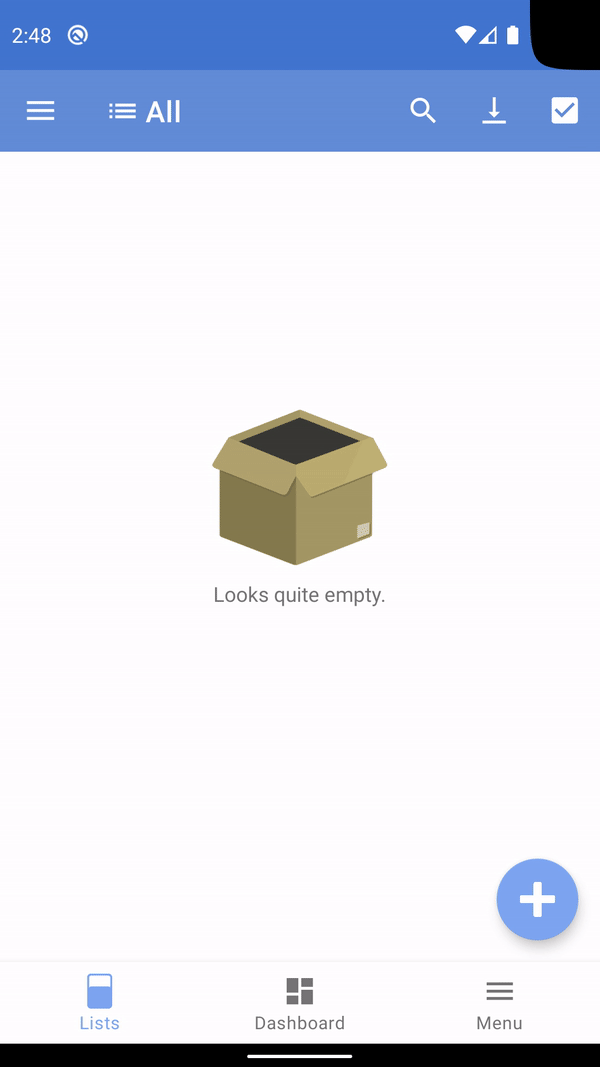在BottomNavigationView中切换标签时的延迟
我有一个包含BottomNavigationView的活动,这个bottomnav帮助该活动显示三个片段。这些片段加载良好,我使用AsyncTask来完成每一个繁重的操作,而在UI线程中,我会显示一个ProgressBar,直到所有内容都加载<我的片段有一个奇怪的行为:第一次加载片段时,实际显示它需要一些时间,而不是用进度条立即显示<这件事只有第一次发生,而且只发生在这个片段中<片段代码仅包含以下内容:
@Override
public void onActivityCreated(@Nullable Bundle savedInstanceState) {
super.onActivityCreated(savedInstanceState);
new LoadData(getView(), getContext()).execute();
}
private class LoadData extends AsyncTask<Void, Void, Void> {
private View v;
private Context context;
public LoadData(View v, Context context) {
items = new ArrayList<>();
this.v = v;
this.context = context;
}
@Override
protected Void doInBackground(Void... voids) {
setItems(context); //Heavy operation
adapter = new DashAdapter(items, context);
return null;
}
@Override
protected void onPreExecute() {
super.onPreExecute();
//shows progressbar
progress = v.findViewById(R.id.DFProgress);
progress.setVisibility(View.VISIBLE);
}
@Override
protected void onPostExecute(Void aVoid) {
super.onPostExecute(aVoid);
setPager();
//sets viewPager and hides progressbar
progress.setVisibility(View.GONE);
}
}

我如何才能使片段以正确的方式加载?
共有3个答案
当我尝试@KasımÖzdemir的答案时,每次活动启动时,底部导航视图中的第一个项目都会产生最初的连锁反应。(因为我使用的是material bottom navigation view,它具有默认的连锁反应。而且当我第一次点击时UI不可见,但我认为这是因为我使用了与@KasımÖzdemir不同的方法来更改单击项目时的活动片段。
我不想从第一个项目开始我的活动,而是从导航视图中的中间项目开始,在下面的案例中是“FragmentTwo”。所以涟漪效应是无关紧要的。
所以,我只是附加了片段,而不是添加它,然后隐藏它,现在没有涟漪,下面是代码在Kotlin中的外观。。。
val firstFragment: Fragment = FragmentOne()
val middleFragment: Fragment = FragmentTwo()
val thirdFragment: Fragment = FragmentThree()
var fragment: Fragment? = null
var bnv: BottomNavigationView? = null
bnv = findViewById(R.id.bottom_navigation)
bnv!!.selectedItemId = R.id.middle_page
//fragments attached other than the fragment linked with middle item
supportFragmentManager.beginTransaction().attach(firstFragment).commit()
supportFragmentManager.beginTransaction().attach(thirdFragment).commit()
supportFragmentManager.beginTransaction().add(R.id.activity_main_container, middleFragment())
.commit()
bnv!!.setOnItemSelectedListener { item ->
when (item.itemId) {
R.id.first_page -> fragment = firstFragment
R.id.middle_page -> fragment = middleFragment
R.id.third_page -> fragment = thirdFragment
}
if (item.isChecked){
false
}
else {
supportFragmentManager.beginTransaction()
.setCustomAnimations(R.anim.fade_in, R.anim.fade_out).replace(
R.id.activity_main_container,
fragment!!
).commit()
true
}
}
因此,使用附加也可以很好地工作,而不是添加然后隐藏它。。。有关更多信息,请查看此答案
(如果您还没有,请尝试使用导航组件进行底部导航,如下图所示。在某些情况下,它更方便,因为它可以自行处理默认的Backback管理。)
您可以使用jetpack导航进行简单的底部栏导航
带Jetpack导航的简单底部导航:
让我们首先在应用程序的build.gradle文件中添加以下行,在应用程序中包含Jetpack导航库:
def nav_version = "2.1.0"
implementation "androidx.navigation:navigation-fragment-ktx:$nav_version"
implementation "androidx.navigation:navigation-ui-ktx:$nav_version"
我们首先创建一个简单的底部导航流。为此,您需要首先在单个活动布局文件中添加NavHostFrament。将其添加到FrameLayout标记内的activity_main.xml文件中。
<fragment
android:id="@+id/fragNavHost"
android:name="androidx.navigation.fragment.NavHostFragment"
android:layout_width="match_parent"
android:layout_height="match_parent"
app:defaultNavHost="true"
app:navGraph="@navigation/bottom_nav_graph" />
您将看到一个错误,显示“无法解析符号@导航/bottom_nav_graph”
<?xml version="1.0" encoding="utf-8"?>
<navigation xmlns:android="http://schemas.android.com/apk/res/android"
xmlns:app="http://schemas.android.com/apk/res-auto"
xmlns:tools="http://schemas.android.com/tools"
android:id="@+id/bottom_nav_graph.xml"
app:startDestination="@id/homeFragment2">
<fragment
android:id="@+id/homeFragment2"
android:name="com.wajahatkarim3.bottomnavigationdemo.HomeFragment"
android:label="fragment_home"
tools:layout="@layout/fragment_home" />
<fragment
android:id="@+id/searchFragment2"
android:name="com.wajahatkarim3.bottomnavigationdemo.SearchFragment"
android:label="fragment_search"
tools:layout="@layout/fragment_search" />
<fragment
android:id="@+id/notificationsFragment2"
android:name="com.wajahatkarim3.bottomnavigationdemo.NotificationsFragment"
android:label="fragment_notifications"
tools:layout="@layout/fragment_notifications" />
<fragment
android:id="@+id/profileFragment2"
android:name="com.wajahatkarim3.bottomnavigationdemo.ProfileFragment"
android:label="fragment_profile"
tools:layout="@layout/fragment_profile" />
</navigation>
是时候在我们的活动类中添加一些代码了。打开MainActivity。kt文件,并在其中创建方法setupViews()。在活动的onCreate()中调用此函数。在setupVeiws()方法中添加这些行。
fun setupViews()
{
// Finding the Navigation Controller
var navController = findNavController(R.id.fragNavHost)
// Setting Navigation Controller with the BottomNavigationView
bottomNavView.setupWithNavController(navController)
// Setting Up ActionBar with Navigation Controller
// Pass the IDs of top-level destinations in AppBarConfiguration
var appBarConfiguration = AppBarConfiguration(
topLevelDestinationIds = setOf (
R.id.homeFragment,
R.id.searchFragment,
R.id.notificationsFragment,
R.id.profileFragment
)
)
setupActionBarWithNavController(navController, appBarConfiguration)
}
我也有同样的问题。我有两个选择。
- 调用LoadData或 时使用后置延迟
- 首先手动添加所有片段。您自己管理导航项。
这样地:
val firstFragment: Fragment = FirstFragment()
val secondFragment: Fragment = SecondFragment()
val thirdFragment: Fragment = ThirdFragment()
val navView: BottomNavigationView = findViewById(R.id.nav_view)
var active = firstFragment
fm.beginTransaction().add(R.id.nav_host_fragment, thirdFragment, "3").hide(thirdFragment).commit()
fm.beginTransaction().add(R.id.nav_host_fragment, secondFragment, "2").hide(secondFragment).commit()
fm.beginTransaction().add(R.id.nav_host_fragment, firstFragment, "1").commit()
navView.setOnNavigationItemReselectedListener { }
navView.setOnNavigationItemSelectedListener { item ->
when (item.itemId) {
R.id.navigation_first -> {
fm.beginTransaction().hide(active).show(firstFragment).commit()
active = firstFragment
}
R.id.navigation_second -> {
fm.beginTransaction().hide(active).show(secondFragment).commit()
active = secondFragment
}
R.id.navigation_third -> {
fm.beginTransaction().hide(active).show(thirdFragment).commit()
active = thirdFragment
}
}
true
}
并删除nav\u host\u片段中的这些行:
app:defaultNavHost="true"
app:navGraph="@navigation/mobile_navigation"
-
我有一个带有的布局,属性设置为: 菜单有五项: 第三项标签过长(第二个单词没有省略,只是没有显示): 标签稍微短一点会导致正确的行为: 有没有办法处理更长的标签?最好的解决方案是省略号并显示“更长的文本…”当全文没有空间时。
-
Google发布了带有BottomNavigationView的新支持库v25 有什么方法可以去除物品标签吗?
-
我正在使用: Chrome55.0.2 Selenium WebDRiver 3.0.1与ChromeDRiver C#4.6.1(VS2015社区版) 我正在编写打开Chrome的自动化代码,打开一个选项卡,并导航到一个主页面URL。这个主页有我解析生成二级页面URL的信息。我的问题是,我不能编写在二级页面加载后切换回主页选项卡的代码,也不能编写从不离开主页的代码。我将解释我所追求的两个选择:
-
这是我第一次尝试开发android应用程序。 我有一个带有ConstraintLayout的MainActivity,它具有BottomNavigationView。每当选择第一个导航项时,我想显示一个类别列表(显示在片段中),然后每当选择此类别时,将显示与该特定类别相关的另一个列表(显示在另一个片段中)。 我读到(Android-fragment.replace()不替换内容-将其放在顶部)它指
-
我正在使用Selenium和Java,我正在使用这段代码在Mozilla中的选项卡之间切换,但它打开了一个新窗口而不是新选项卡。如何解决这个问题,或者有没有另一种在选项卡之间切换的方法?
-
问题内容: 我有一个标签栏应用程序,并且在我的第一个视图上有一个按钮,当我按下该按钮时,需要在标签栏中以编程方式切换到第二个标签页。 我似乎不太明白如何获取索引等以切换到它,我已经尝试过类似的东西。 没有成功。 问题答案: 多数民众赞成在非常简单的tabBarController被声明为可选类型 视图控制器层次结构中最接近的祖先,它是一个标签栏控制器。如果视图控制器或其祖先之一是标签栏控制器的子代

